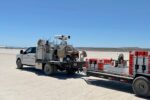U.S. shipbuilder Metal Shark and defense technology startup HavocAI have announced a strategic partnership aimed at integrating advanced artificial intelligence into autonomous surface vessels (USVs). The move signals a deepening convergence between naval platform manufacturers and AI software developers as the U.S. Navy accelerates its push toward distributed maritime operations and unmanned systems.
Strategic Alignment Between Shipbuilding and Autonomy
Based in Louisiana, Metal Shark has built a reputation for rapidly delivering small to medium-sized combatant craft to the U.S. Navy, Coast Guard, and foreign military customers. Its portfolio includes patrol boats, interceptors, and increasingly, unmanned surface vessels (USVs). The company has been involved in several key programs including the U.S. Navy’s Next Generation Small Combatant initiatives.
HavocAI is a relatively new entrant in the defense tech space but has quickly gained attention for its proprietary autonomy stack designed for contested environments. Unlike traditional waypoint-based autonomy providers, HavocAI focuses on real-time decision-making under uncertainty—an essential capability for autonomous systems operating in dynamic maritime threat environments.
The partnership aims to combine Metal Shark’s proven hull platforms with HavocAI’s mission autonomy software to create modular USV solutions capable of ISR (intelligence-surveillance-reconnaissance), force protection, mine countermeasures (MCM), electronic warfare (EW), and even kinetic strike missions.
Focus on Modular Autonomy for Mission Flexibility
A key feature of the collaboration is modularity—both in terms of hardware payloads and software-defined mission profiles. According to statements from both companies at AUSA 2025 and subsequent interviews with Naval News, the joint offering will support plug-and-play mission modules that can be swapped or updated depending on operational requirements.
- ISR Payloads: EO/IR sensors with onboard processing for target classification
- MCM Modules: Towed sonar arrays or expendable mine neutralization payloads
- C2 Integration: Link-16 compatibility for networked operations with manned assets
- Kinetic Options: Provisioning for lightweight missile or loitering munition launchers
This modularity is underpinned by HavocAI’s autonomy stack which supports dynamic re-tasking mid-mission without requiring operator intervention—a critical capability in GPS-denied or communications-contested environments.
A Response to Evolving Naval Warfare Doctrine
The timing of this partnership aligns closely with evolving U.S. Navy doctrine emphasizing Distributed Maritime Operations (DMO) and Expeditionary Advanced Base Operations (EABO). Both concepts rely heavily on unmanned systems to extend sensor reach, complicate enemy targeting cycles, and reduce risk to human operators.
The recent deployment of Ghost Fleet Overlord USVs such as Sea Hunter by the U.S. Navy has demonstrated the viability of long-endurance autonomous platforms. However, many of these systems remain limited by brittle autonomy frameworks that struggle in cluttered littoral zones or when facing adversarial EW tactics.
HavocAI claims its system is designed from the ground up for adversarial robustness—leveraging reinforcement learning techniques trained on simulated red-force behaviors as well as real-world data collected during joint exercises with DoD partners.
Manned-Unmanned Teaming at Sea
An important aspect of this collaboration is enabling seamless manned-unmanned teaming (MUM-T) between crewed Metal Shark vessels and their autonomous counterparts. This would allow small naval task forces to deploy mixed formations where human-crewed boats provide command oversight while USVs conduct forward reconnaissance or perimeter defense missions autonomously.
This approach mirrors developments seen in air domain MUM-T programs such as Skyborg or Loyal Wingman but adapted for maritime dynamics including wave action prediction models, acoustic signature management, and cooperative navigation algorithms across multiple hull types.
Path Toward Operational Fielding
The companies did not disclose specific program timelines but confirmed that prototype integration has already begun at Metal Shark’s Jeanerette facility in Louisiana using their 40-foot Defiant-class hull as a testbed platform. Early sea trials are expected by Q1 2026 with participation from DoD evaluators under Other Transaction Authority (OTA) agreements facilitated through NAVSEA’s Unmanned Maritime Systems Program Office (PMS-406).
If successful in demonstrations—including GPS-denied navigation tests—the integrated solution could feed into larger acquisition programs such as MUSV (Medium Unmanned Surface Vehicle) or serve allied export markets seeking affordable autonomous patrol craft options.
Industry Implications Beyond Defense Markets
While initially focused on military applications, both firms hinted at dual-use potential including port security automation, anti-piracy patrols for commercial shipping lanes, environmental monitoring missions under NOAA contracts, or disaster response operations where human access is limited post-cyclone or tsunami events.
This reflects a broader trend where defense-grade autonomy stacks are being adapted into civil maritime safety frameworks—mirroring how UAV technologies have migrated from ISR missions into wildfire monitoring or border surveillance roles globally.
Conclusion: A Tactical Edge Through Integrated Innovation
The Metal Shark–HavocAI partnership represents more than just another OEM-supplier relationship; it embodies a shift toward vertically integrated innovation cycles where platform builders tightly couple with software-first autonomy firms from day one of design planning. As navies worldwide seek greater operational tempo with smaller crews—and higher survivability through distributed assets—such collaborations may define the next generation of naval force structure design.









